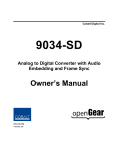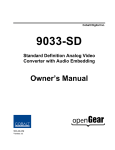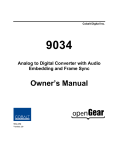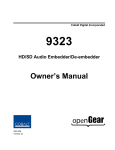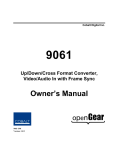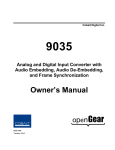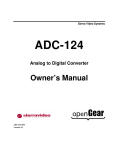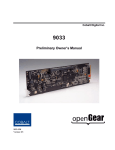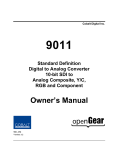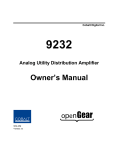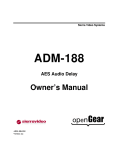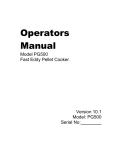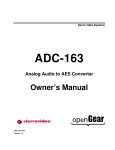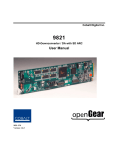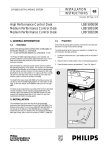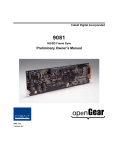Download SIERRA VIDEO SYSTEMS ADC-142 Owner`s manual
Transcript
Sierra Video Systems
ADC-142
Analog to Digital Converter with Audio
Embedding and Frame Sync
Owner’s Manual
ADC-142-OM
Version: 2.1
ADC-142 • HD/SD Analog to Digital Converter with Audio Embedding and Frame
Sync Owner’s Manual
•
•
•
•
•
Sierra Part Number: ADC-142-OM
Document Version: 2.1
Printed in the United States.
Last Author: MB
Printing Date: 11/29/2010 9:34:00 AM
The information contained in this Owner’s Manual is subject to change without notice or obligation.
Copyright
© 2010 Sierra Video Systems All rights reserved.
Contents of this publication may not be reproduced in any form without the written permission of
Sierra Video Systems Reproduction or reverse engineering of copyrighted software is prohibited.
Notice
The material in this manual is furnished for informational use only. It is subject to change without
notice and should not be construed as a commitment by Sierra Video Systems Sierra Video Systems Inc
assumes no responsibility or liability for errors or inaccuracies that may appear in this manual.
Trademarks
Page 2 of 29
•
is a registered trademark of Ross Video Limited.
•
•
is a registered trademark of Sierra Video Systems
All other product names and any registered and unregistered trademarks mentioned in this
manual are used for identification purposes only and remain the exclusive property of
their respective owners.
ADC-142 Owner’s Manual • (V 2.1)
Important Regulatory and Safety Notices
Before using this product and any associated equipment, refer to the “Important Safety Instructions”
listed below so as to avoid personnel injury and to prevent product damage.
Products may require specific equipment, and /or installation procedures be carried out to satisfy
certain regulatory compliance requirements. Notices have been included in this publication to call
attention to these specific requirements.
Symbol Meanings
This symbol on the equipment refers you to important operating and maintenance
(servicing) instructions within the Product Manual Documentation. Failure to heed
this information may present a major risk of damage or injury to persons or
equipment.
The symbol with the word “Warning” within the equipment manual indicates a
potentially hazardous situation, which if not avoided, could result in death or serious
injury.
Warning
The symbol with the word “Caution” within the equipment manual indicates a
potentially hazardous situation, which if not avoided, may result in minor or
moderate injury. It may also be used to alert against unsafe practices.
Caution
The symbol with the word “Notice” within the equipment manual indicates a
situation, which if not avoided, may result in major or minor equipment damage or a
situation which could place the equipment in a non-compliant operating state.
Notice
This symbol is used to alert the user that an electrical or electronic device or
assembly is susceptible to damage from an ESD event.
ESD
Susceptibility
Important Safety Instructions
Caution
This product is intended to be a component product of the openGearTM frame. Refer
to the openGearTM frame Owner’s Manual for important safety instructions regarding
the proper installation and safe operation of the frame as well as it’s component
products.
Warning
Certain parts of this equipment namely the power supply area still present a safety
hazard, with the power switch in the OFF position. To avoid electrical shock,
disconnect all A/C power cords from the chassis' rear appliance connectors before
servicing this area.
Warning
Service barriers within this product are intended to protect the operator and service
personnel from hazardous voltages. For continued safety, replace all barriers after
any servicing.
This product contains safety critical parts, which if incorrectly replaced may present
a risk of fire or electrical shock. Components contained within the product’s power
supplies and power supply area, are not intended to be customer serviced and should
be returned to the factory for repair.
To reduce the risk of fire, replacement fuses must be the same type and rating.
Only use attachments/accessories specified by the manufacturer.
ADC-142 Owner’s Manual • (V 2.1)
Page 3 of 29
Environmental Information
The equipment that you purchased required the extraction and use of natural resources for its
production. It may contain hazardous substances that could impact health and the environment.
To avoid the potential release of those substances into the environment and to diminish the need for the
extraction of natural resources, Sierra Video Systems encourages you to use the appropriate take-back
systems. These systems will reuse or recycle most of the materials from your end-of-life equipment in
an environmentally friendly and health conscious manner.
The crossed-out wheeled bin symbol invites you to use these systems.
If you need more information on the collection, reuse, and recycling systems, please contact your local
or regional waste administration.
You can also contact Sierra Video Systems for more information on the environmental performances of
our products.
Page 4 of 29
ADC-142 Owner’s Manual • (V 2.1)
Contents
Introduction
6
In This Chapter .......................................................................................................................... 6
A Word of Thanks ..................................................................................................................... 6
Overview.................................................................................................................................... 6
Functional Block Diagram ......................................................................................................... 8
Supported Audio and Video Formats......................................................................................... 8
Input and Output Video ............................................................................................... 8
Analog Audio .............................................................................................................. 8
Discrete AES Audio Input ........................................................................................... 8
Discrete AES Audio Output ........................................................................................ 9
AES Audio Input Advanced Features ........................................................................................ 9
AES Sample Rate Converter Bypass ........................................................................... 9
Zero-Delay Audio Embedding..................................................................................... 9
Low latency AES Passthrough..................................................................................... 9
Documentation Terms ................................................................................................................ 9
Installation and Setup
10
In This Chapter ........................................................................................................................ 10
Static Discharge ....................................................................................................................... 10
Unpacking ................................................................................................................................ 10
Rear Module Installation (Optional) ........................................................................................ 11
Rear Modules Available for ADC-142 .................................................................................... 12
Board Installation..................................................................................................................... 13
Card Control and Status ........................................................................................................... 14
Card Status ................................................................................................................ 14
Menu Navigation ....................................................................................................... 14
Menu Structure ........................................................................................................................ 14
Factory Default Settings ............................................................................................ 18
Remote Control
19
In This Chapter ........................................................................................................................ 19
DashBoard Control System Software ...................................................................................... 19
Technical Specifications
22
Service Information
24
In This Chapter ........................................................................................................................ 24
Troubleshooting Checklist ....................................................................................................... 24
Warranty and Repair PolicyError! Bookmark not defined.Error! Bookmark not defined.Error! Bookma
Ordering Information
27
ADC-142 and Related Products ............................................................................................... 27
Contact Us
29
Contact Sierra Video Systems.................................................................................................. 29
Visit us at the Sierra Video Systems website. .......................................................................... 29
ADC-142 Owner’s Manual • (V 2.1)
Page 5 of 29
Introduction
In This Chapter
This chapter includes the following sections:
•
A Word of Thanks
•
Overview
•
Functional Block Diagram
•
Supported Audio and Video Formats
•
Documentation Terms
A Word of Thanks
Congratulations on choosing the openGearTM ADC-142 Analog to Digital Converter with Audio
Embedding and Frame Sync. The ADC-142 is part of a full line of modular conversion gear for
broadcast TV environments. The Sierra Video Systems openGearTM line includes video decoders and
encoders, audio embedders and de-embedders, distribution amplifiers, format converters, and much
more. Sierra openGearTM modular conversion gear will meet your signal conversion needs now and
well into the future.
Should you have questions pertaining to the installation or operation of your ADC-142, please contact
us at the numbers listed on the back cover of this manual. We are happy to help with any questions
regarding this or any other openGearTM card.
Overview
The ADC-142 is a high quality format converter that also includes a full 16 channel audio embedder, a
12-bit analog to digital video converter, a 8 channel 24-bit balanced analog to digital audio converter,
and a full video frame synchronizer.
The ADC-142 has a full featured, high quality, 12-bit analog to 10-bit serial digital converter. The dual
rate HD/SD analog video input can accept all common analog video formats and will autodetect
between HD and SD.
The embedder functions like an audio router internal to the card. On the input side of the router are the
up to 16 channels (8 pairs) of discrete AES input, up to 8 channels of differential analog audio input.
On the output side are the up to 16 channels of embedded AES audio, and the up to 16 channels (8
pairs) of discrete AES output. The router acts as a full audio cross point: each of the 32 output channels
(16 embedded AES, 16 discrete AES) can receive signal from any one of the 29 (16 discrete AES, 8
Analog, 4 tone generator, 1 silence) input channels. Each output also allows gain adjustment and
optional polarity inversion.
Page 6 of 29
ADC-142 Owner’s Manual • (V 2.1)
Audio rates are always 48kHz nominally but discrete AES inputs pass through sample rate converters
to align them with the output timing. The sample rate converters can be disabled if necessary. Output
AES is always precisely locked in time with the output video. Analog audio is differential input and
sampled at 48 kHz with 0 dbFS digital equivalent to a +24 dBu analog.
There are several advanced features available for the AES inputs. These include input sample rate
converter bypass, low-latency embedding of AES inputs, and AES input to output pass through. These
are covered in more detail in the section: AES Audio Input Advanced Features.
The product also provides full color processing control of the output video, with separate controls for
Luma Gain, Luma Lift, Chroma Saturation and Color Phase.
All card configuration is done with a simple front panel menu. There is a four character text display to
view and control parameters, and a toggle switch and two buttons to navigate the menu. Card
configuration can also be done over Dashboard remote control software.
The input and outputs of the ADC-142 are the following:
Input:
One 3-BNC dual-rate HD/SD analog video input
4 dedicated AES input connections (AES input 5-6)
8 differential analog audio inputs
Switchable Input/Outputs:
4 AES connections, switchable between input and output (AES input/output 1-4)
Outputs:
Two dual-rate HD/SD-SDI video outputs
8 dedicated AES output connections. (AES output 1-8)
ADC-142 Owner’s Manual • (V 2.1)
Page 7 of 29
Functional Block Diagram
The ADC-142 has a very flexible signal flow path and feature set that combines several products into
one compact package. This section diagrams the basic signal flow of your ADC-142 product.
Video
Analog
Video Input
Analog
Video A/D
8 channels
Diff. Analog
Audio A/D
Frame
Sync
Video Proc:
Gain, Lift, Saturation, Phase
Audio Control:
8 pairs
16 channels
AES
Decode
and SRC
From AES or
Embedded Audio
Dolby E
Decode
and SRC
Routing
Gain
Polarity
FS
Tracking
Delay +
User
Offset
Video
Audio
Embed
Serializer
and Cable
Driver
AES
Encode
8 pairs
16 channels
ADC-142 Block Diagram
Figure 1. Simplified Block Diagram of ADC-142 Functions
Supported Audio and Video Formats
Input and Output Video
The ADC-142 supports the complete range of modern SMPTE standard SD and HD video formats.
Raster structure Frame Rate
1080psF
23.98, 24
1080p
23.98, 24
1080i1
25, 29.97, 30
720p
25, 29.97, 30, 50, 59.94, 60
486i1
29.97
575i1
25
Notes:
1.
All rates displayed as frame rates, interlaced (“i”) field rates are two times the number shown.
Analog Audio
The ADC-142 supports 8 channels differential analog audio. The analog audio is converted in such a
way as to make +24 dBu (analog) equivalent to 0 dBFS (digital).
Discrete AES Audio Input
The ADC-142 can accept 16 channels (8 pairs) of discrete AES audio on 75 ohm BNC connections.
The AES must have a nominal rate of approximately 48 kHz. Sample rate conversion is employed to
account for minor clock rate differences in the input AES stream and the input video stream. However,
the card does not support AES input at 32 kHz, 44.1 kHz, 96 kHz or 192 kHz rates.
Page 8 of 29
ADC-142 Owner’s Manual • (V 2.1)
Discrete AES Audio Output
The ADC-142 can emit 16 channels (8 pairs) of discrete AES audio on 75 ohm BNC connections. The
AES clock rate will be precisely locked to the output video rate.
AES Audio Input Advanced Features
AES Sample Rate Converter Bypass
The card’s AES inputs have built in sample rate converters that are enabled by default. This allows the
card to interface with asynchronous AES sources (sources who’s AES timing does not match the video
reference timing.). They can be bypassed with a control in Dashboard or the front panel. This is a
necessity when trying to embed non-PCM AES audio such a Dolby E or Dolby Digital audio streams.
This control is off by default.
Zero-Delay Audio Embedding
Sometimes it is desirable to embed AES with minimum latency. For example, if you want to embed
Dolby E audio into video with no latency, and delay the video by one frame to account for Dolby E
encoding delay. By turning this control on for a given AES pair, the pair will be directly embedded into
it’s corresponding group, bypassing the normal frame sync audio delay. (AES Pair 1 into Embedded
Group 1, ch1 & ch2, AES pair 2 into Embedded Group 2, ch3 & ch4). This control overrides the
standard audio routing system: if AES Pair 1 is selected, then the controls to route into Embedded
group 1, ch1 & ch2 don’t apply. There is no gain or polarity control available when this option is
selected. This control is off by default
Low latency AES Passthrough
This control is similar to zero delay audio embedding. If selected for input pair X it causes AES output
pair X to act as a bit for bit copy of AES input pair X. This over rides the normal audio routing and
delay. No gain and polarity adjustments are possible. This control is off by default.
Documentation Terms
The following terms are used throughout this guide:
•
“Frame” refers to the 8310 frame that houses the ADC-142 card.
•
“Operator” and “User” both refer to the person who uses the ADC-142.
•
“Board” and “Card” all refer to the ADC-142 card itself, including all components
and switches.
•
“System” and “Video system” refers to the mix of interconnected production and
terminal equipment in which the ADC-142 operates.
ADC-142 Owner’s Manual • (V 2.1)
Page 9 of 29
Installation and Setup
In This Chapter
This chapter includes the following sections:
•
Static Discharge
•
Unpacking
•
Rear Module Installation (Optional)
•
Board Installation
•
BNC Connections
•
Menu Structure
•
Factory Defaults
Static Discharge
Whenever handling the card and other related equipment, please observe all static discharge
precautions as described in the following note:
Static discharge can cause serious damage to sensitive
semiconductor devices. Avoid handling circuit boards in high
static environments such as carpeted areas, and when wearing
synthetic fiber clothing. Always exercise proper grounding
precautions when working on circuit boards and related
equipment.
ESD
Susceptibility
Unpacking
Unpack each card you received from the shipping container, and check the contents against the packing
list to ensure that all items are included. If any items are missing or damaged, contact your sales
representative or Sierra Video Systems directly.
Page 10 of 29
ADC-142 Owner’s Manual • (V 2.1)
Rear Module Installation (Optional)
If you are installing the card in a 8310-C-BNC or 8310-BNC frame (one with a 100 BNC rear module
installed across the entire back plane), skip this section.
If you are installing the card into a slot with no rear module, you should have ordered and received one
of the following modules; ADC-142-A, ADC-142-B, ADC-142-C, or ADC-142-D. You will need to
install it in your 8310 frame before you can connect cables.
Use the following steps to install a rear module in an 8310 openGearTM frame:
1.
Refer to the openGearTM 8310 frame Owner’s Manual, to ensure that the frame is
properly installed according to instructions.
2.
On the rear of the 8310, locate the card frame slot.
3.
As shown in Figure 2, seat the bottom of the rear module in the seating slot at the
base of the frame’s back plane.
Figure 2. Rear Module Installation
4.
Align the top hole of the ADC-142-A with the screw hole on the top edge of the 8310
back plane.
5.
Using a Phillips driver and the supplied screw, fasten the rear module to the 8310
back plane. Do not over tighten.
All modules are installed using the same method above.
The following section contains a table of all of the optional rear modules available for the ADC-142.
ADC-142 Owner’s Manual • (V 2.1)
Page 11 of 29
Rear Modules Available for ADC-142
Figure 3. BNC Designations for the Card Rear Modules available for the ADC-142.
NC
Y/
CMPST
NC
Y/
CMPST
Pr/C
Pb
Pr/C
Pb
AES IN/
OUT 2
Analog
Analog
Audio IN text Audio IN
1
2
AES IN/
OUT 3
AES IN/
OUT 4
Analog
Audio IN
3
Analog
Audio IN
4
SDI
OUT
SDI
OUT
SDI
OUT
SDI
OUT
AES IN/
OUT 1
text
ADC-142-A
AES IN
5
AES IN
6
Analog
Audio IN
1
Analog
Audio IN
2
Analog
Audio IN
3
Analog
Audio IN
4
Analog
Audio IN
5
Analog
Audio IN
7
NC
Y/
CMPST
AES
OUT 1
AES
OUT 2
SDI IN
Y/
CMPST
Pr/C
Pb
AES
OUT 3
AES
OUT 4
Pr/C
Pb
AES IN/
OUT 1
AES IN/
OUT 2
AES
OUT 5
AES
OUT 6
AES IN/
OUT 1
AES IN/
OUT 2
Analog
Audio IN
6
AES IN/
OUT 3
AES IN/
OUT 4
AES IN
5
AES IN
6
AES IN/
OUT 3
AES IN/
OUT 4
Analog
Audio IN
8
SDI
OUT
SDI
OUT
AES IN
7
AES IN
8
SDI
OUT 1
SDI
OUT 2
text
ADC-142-C
Page 12 of 29
ADC-142-B
text
ADC-142-D
ADC-142 Owner’s Manual • (V 2.1)
Board Installation
Use the following steps to install the card in the openGearTM 8310 frame:
1.
Warning
Refer to the Owner’s Manual of the openGearTM 8310 frame to ensure that the frame
is properly installed according to instructions.
Heat and power distribution requirements within a frame may dictate
specific slot placement of cards. Cards with many heat-producing
components should be arranged to avoid areas of excess heat build-up,
particularly in frames using convection cooling.
2.
After selecting the desired frame installation slot, hold the card by the edges and
carefully align the card edges with the slots in the frame. Then, fully insert the card
into the frame until the rear connection plugs are properly seated on the midplane and
rear modules.
This completes the procedure for installing the card in the openGearTM 8310 frame.
ADC-142 Owner’s Manual • (V 2.1)
Page 13 of 29
Card Control and Status
Card Status
The card indicates the status of the input signal with the four blue LEDs labeled with the different
supported formats (1080, 720, 625, 525). When the card has locked to a particular input format, that
LED will be illuminated. When the card has not locked to a particular video format, the card will
search all possible formats, and the lights will cycle rapidly.
Menu Navigation
The card can be configured from a menu system built in to the front card edge. This provides an
intuitive and easy to use method for exploring and using the features of the card.
The menu is navigated by using the toggle switch and the two push buttons. The lower button is the
“Enter” button to enter a submenu, and the upper button is the “Exit” button to exit a submenu. Moving
the toggle switch up or down moves up or down in menu choices, and pressing the buttons moves in or
out of sub menus.
The menu LEDs will illuminate from top to bottom to indicate increasing depth in the menu.
Menu Structure
Video Submenu
Menu Structure
Vid
Proc
Dec
Unty
Gain
Lift
Sat
Phas
SDIN
HDIN
PED
Parameter Type
Proc Unity
Proc Gain
Proc Lift
Proc Sat
Proc Phase
Decoder SD input
Decoder HD input
Pedestal - SD Setup
Proc Unity
Resets all of the proc controls to unity value.
Proc Gain
This is Luma (Y channel) gain, expressed as a percentage. It ranges from 0.0% to 200.0% in 0.1%
steps.
Proc Lift
This is Luma (Y channel) offset, expressed as an actual video value ranging from -1024 to 1024. If set
to 0 no change is made. If set to 1024 absolute black (value 004) becomes absolute white (value 3FB).
If set to –1024, absolute white becomes absolute black.
Proc Saturation
This is Chroma (C channel) gain, expressed as a percentage. It ranges from 0.0% to 200.0% in 0.1%
steps.
Page 14 of 29
ADC-142 Owner’s Manual • (V 2.1)
Proc Phase
This is Chroma (C channel) phase adjustment, expressed in degrees, ranging from –360 to +360 in
steps of one degree.
Decoder SD Input
Selects the input format for SD analog video. This must be changed to reflect the analog video format
on the input for the ADC-142 to lock correctly. Valid SD formats are GBR, Component SMPTE,
Component MII, Component Betacam, Component Y/C, and Composite.
Decoder HD Input
Selects the input format for HD analog video. The user must select between GBR and YPbPr for the
ADC-142 to lock to the input correctly.
SD Pedestal (Setup)
Selects between 0 IRE and 7.5 IRE of setup (pedestal)on the input analog SD signal. This tells the card
how much setup needs to be removed from the input.
Frame Sync Submenu
Menu Structure
FS
Enbl
HOS
VOS
LATL
LATF
ADLY
RSET
Parameter Type
Frame Sync Enable
Horizontal Offset
Vertical Offset
Line Latency
Field Latency
Audio Delay
Frame Sync Reset
Frame Sync Enable
Enables the frame sync. If disabled the output video timing matches the input video timing.
Horizontal Offset
Allows the user to specify an additional horizontal offset between the output video and the frame sync
reference in sample clock periods. These are sample clocks in the reference format, not the output
video format. For example, if using SD black burst to time 720p59.94 video each sample clock is 37ns,
not 13.5ns.
Vertical Offset
Allows the user to specify an additional vertical offset between the output video and the frame sync
reference in lines. These are lines in the reference format, not the output video format.
Frame Latency
Specifies the smallest amount of latency allowed by the frame sync. This latency measurement is in
frames of the output video. The frame sync will not output a frame unless the specified number of
frames are captured in the buffer. Minimum latency is three lines and zero frames in all video modes.
The maximum latency is format dependent. The operational latency of the frame sync is always
between the specified minimum latency and minimum latency plus one frame (not one field).
ADC-142 Owner’s Manual • (V 2.1)
Page 15 of 29
Audio Delay
Specifies the amount of additional audio delay after matching video delay. When the change is under
one and a half frames, the change in audio delay will be applied without interrupting audio. When
changing audio delay more than a frame and a half at a time, there will be a slight audio glitch.
Video Delay
Reports the current amount of video delay in ms.
Reset Frame Sync
Resets the frame sync, clearing any buffered audio and video. You must reset the framesync after
manipulating the horizontal and vertical offset in order re-establish correct audio and video co-timing.
Audio Submenu
Menu Structure
Aud
Embd Grp1
AES
Tone
Enbl
Ch01Ch04
(x4)
Grp2
Enbl
Ch05Ch08
(x4)
Grp3
Enbl
Ch09Ch12
(x4)
Grp4
Enbl
Ch13Ch16
(x4)
Ch01- Src
Ch16 Gain
(x16) Pol
TG1-TG4 (x4)
Src
Gain
Pol
Src
Gain
Pol
Src
Gain
Pol
Src
Gain
Pol
Parameter Type
Embedded Group Enable
Output Source
Output Gain
Output Polarity
Embedded Group Enable
Output Source
Output Gain
Output Polarity
Embedded Group Enable
Output Source
Output Gain
Output Polarity
Embedded Group Enable
Output Source
Output Gain
Output Polarity
Output Source
Output Gain
Output Polarity
Tone Frequency
Embedded Group Enable
Enables or disables the embedding of a particular embedded audio group. Disabling a group preserves
the settings of the channels belonging to that group.
Output Source
Because the cards audio system functions like a router, each output can be sourced from any input
channel. This parameter lets you choose from the many different sources. Here is an explanation of the
different source names:
Page 16 of 29
Source Name
Description
AeXX
Discrete AES channel XX (1 through 16)
AnX
Analog Audio channel X (1 through 8)
TgX
Test Generator channel X (1 through 4)
ADC-142 Owner’s Manual • (V 2.1)
Output Gain
The gain of each output is adjustable from +30 dB to –100 dB in 0.1 dB steps. After –100 dB gain is
set to –Inf, which means that output is present, but muted.
Output Polarity
If set to “Norm” output polarity is the same as input polarity, if set to “Inv” the output polarity is
inverted. This can be used to correct polarity errors in the input signals fed to the card.
Tone Frequency
This sets the frequency of the test tone for each of the four tone generators. Each of the four tone
generators TG1 – TG4 can be set to a different frequency, and are available as audio sources for the
embedded or AES audio outputs. The tones can range from 50Hz to 16kHz.
Display Submenu
Menu Structure
Disp H/V
BRGT
Parameter Type
Display Orientation
Display Brightness
Display Orientation
This parameter lets you change the orientation of the display. “Vert” makes the characters look correct
when the cards are mounted in a 2 RU frame like the 8310. “Horz” makes the characters look right in a
horizontal frame.
Display Brightness
This parameter allows you to set the standard output brightness of the menu display. It is a percentage
of maximum brightness.
Preset Submenu
MENU STRUCTURE
Prst
Slct
Save
Load
Fact
Parameter Type
Select Preset
Save Settings
Load Settings
Restore Factory Settings
Select Preset
Select from one of the five saved presets.
Save Settings
In this parameter, move the toggle switch up to save the settings to the card persistent storage.
Load Settings
In this parameter, move the toggle switch up to load the saved settings and make them active.
ADC-142 Owner’s Manual • (V 2.1)
Page 17 of 29
Restore Factory Settings
In this parameter, move the toggle switch up to make the factory default settings active, and make the
stored settings equal to the factory settings.
Information Submenu
Menu Structure
Info
+POW
-POW
SWR#
SWB#
Parameter Type
Positive Watts Consumed
Negative Watts Consumed
Software Release Number
Software Build Number
Positive Watts Consumed
A read only indication of power consumed by the card from the frames +12V rail.
Negative Watts Consumed
A read only indication of power consumed by the card from the frames +-7.5V rail.
Software Release Number
A read only indication of the software release number. A higher number is newer release of software.
Software Build Number
A read only indication of the software build number. Software build number is an internal indicator
used by Sierra engineers to differentiate different software builds.
Factory Default Settings
The factory default settings are as follows
1) The proc module is enabled, but all parameters are set to unity.
2) The audio mapping is for AES Inputs to AES Outputs.
3) Audio gain is set to 0dB and polarity is set to normal on all channels.
4) The Frame Sync is disabled, reference 1 or 2 must be chosen to enable the frame sync.
Page 18 of 29
ADC-142 Owner’s Manual • (V 2.1)
Remote Control
In This Chapter
This section provides a detailed explanation on using remote control functions with your card.
DashBoard Control System Software
The DashBoard Control System enables you to monitor and control openGearTM frames and controller
cards from a computer. The DashBoard software and manual can be downloaded from the Sierra Video
Systems website (www.sierravideo.com).
Using the Menus and Menu Descriptions
You must first install the DashBoard Control System software on your computer. Refer to the
DashBoard User Manual for software installation procedures and for using the DashBoard interface.
The following pages list the parameters from the menu tabs available in the DashBoard software when
connected to a ADC-142.
Menu
Item
Format
Description
Product
ADC-142
The product name
Sierra Video Systems
The manufacturer of the
product
Manufacturer
Card Info
(Read-only)
Software Release
Number
###
The release number of the
firmware in this card
Software Build
Date
###
The internal build number
of this software
Software Build
Time
###
The date and time the
software was created
+12 V Power Rail
#.## W
Positive Supply Power
-7.5 Power Rail
#.## W
Negative Supply Power
Video Input
Standard
############
Detected Video Standard
on SDI or Analog Input
Reference Standard
############
Detected standard of
selected reference.
############
Displays the Silicon Serial
Number of the card.
SSN
ADC-142 Owner’s Manual • (V 2.1)
Page 19 of 29
Menu
Frame Sync
Menu
Item
Format
Framesync Enable
On/Off
Enables the Frame Sync
Horizontal Offset
0-4125 samples
Applies additional
horizontal offset
Vertical Offset
0-1124 lines
Applies additional vertical
offset
Minimum Latency
Lines
3-1124 lines
Selects the minimum lines
of latency allowed.
Minimum Latency
Fields
0-27
Selects the minimum
fields of latency allowed.
Framesync Status
On/Off/Error
Shows the status of the FS
Reset Framesync
Confirm
Resets the FS and its
buffers. Re-establishes
audio video sync after a
adjusting the horizontal
and vertical offsets.
Item
Format
Description
AES 1-16
Silence
Selects the source for the
AES outputs. Each AES
source can be chosen
separately.
Range (-400) - 400
Gain applied to AES
audio output.
Source
(per channel)
AES Audio
Out 1/2 - 7/8
(per channel)
Analog 1-8
Inverts the phase of the
AES audio output.
Phase
Normal
(per channel)
Invert
Menu
Item
Format
Description
Tone
Generator
Tone Generator 1-4
Frequency
Range 50Hz –16KHz
Selects the frequency of
the tone generated.
Menu
Item
Format
Description
Parameter Save
Confirm
Saves the parameters as
preset.
Parameter Load
Confirm
Loads parameters
previously saved.
Restart Parameters
to Factory Default
Confirm
Will load factory presets
and overwrite the save.
Presets
Page 20 of 29
Gain
Description
ADC-142 Owner’s Manual • (V 2.1)
Menu
Item
Format
Description
Composite
Selects the format of
input SD analog video, so
the decoder can properly
decode the signal.
Y/C
SD Input Type
YPbPr BetaCam
YPbPr MII
YPbPr SMPTE
Video Signal
Controls
GBR
HD Input Type
Menu
YPbPr
SD Composite
Contains
0.0 or 7.5 IRE of Setup
Specifies the amount of
setup (pedestal) in the
input video. It will be
removed by the decoder.
Item
Format
Description
On
AES Pair 1-8 SRC
Bypass
Off
AES Input
Controls
Menu
This will bypass sample
rate conversion on AES.
If bypassed AES rate
must match input video
rate or audio dropout will
occur. SRC must be
bypassed to embed Dolby
encoded audio.
AES output pair X will
be a low latency copy of
AES input pair X.
AES Pair 1-8
Passthrough
On
AES Pair 1-8
On
Zero Delay
Off
Embeds with low (<1 ms)
latency. Overrides routing
choices.
Item
Format
Description
Video Gain
Video Proc
Video Lift
ADC-142 Owner’s Manual • (V 2.1)
Selects the format of
input HD analog video.
Off
Range 0-2000
Gain applied to Y (Luma).
1000 is unity.
Range (-999) – 999
Lift applied to Y (Luma),
in 10 bit code value.
Color Gain
Range 0-2000
Gain applied to C
(Chroma). 1000 is unity.
Color Phase
Range (–360) – 360
Phase of C (Chroma) in
degrees.
Reset to Unity
Confirm
Resets all of the proc
controls to unity.
Page 21 of 29
Technical Specifications
Table 4. Card - Technical Specifications
Analog Video
Input
Category
Serial Digital
Video Outputs
Page 22 of 29
Number of Inputs
3
Input Type
Differential, Common Mode Rejection (5V AC)
Video Inputs
HD: Component YPbPr and RGB
SD: Composite, Component YPbPr (BetaCam™,
MII™, SMPTE/N10), RGB, and Y/C
Conversion Bit Depth
12-Bits
SD Color Separation
5-Line Adaptive Comb or Notch Filter
Frequency Response
HD: Y- 0-30MHz ± 0.25db PbPr 0-15 MHz ±
SD: Y- 0-30MHz ± 0.25db PbPr 0-15 MHz ±
Differential Phase
SD: < ±0.4° typical
Differential Gain
SD: < ±0.4% typical
Noise
< -64dB (Luma Flat Field)
< -61dB (Luma Ramp)
Analog Front End Crosstalk
Within Noise Floor Measurement
Return Loss
> 20dB to 30MHz
Parameter
Specification
Number of Outputs
2:HD/SD-SDI BNC per IEC 60169-8 Amendment 2
Impedance
75Ω
Return Loss
> 15 dB at 5MHz – 270MHz
> 12 dB at 270MHz – 1.485GHz
Signal Level
800 mV ±10%
DC Offset
0 Volts ±50 mV
Jitter
HD: < 0.15UI (all outputs)
SD: <0.06UI (all outputs)
Overshoot
<0.2% of amplitude
ADC-142 Owner’s Manual • (V 2.1)
AES Audio
Input
AES Audio
Output
Analog Audio
Input
Category
Standard
SMPTE 276M
Number of Inputs
8 unbalanced
Input Level
0.1 to 2.5V p-p (5V p-p tolerant)
Input Impedance
75Ω
Return Loss
> 12dB 100kHz to 6MHz
Equalization
Automatic to 1000m with Belden 1694A (or
equivalent) @ 48kHz AES signal
Sample Rate
48KHz
Standard
SMPTE 276M
Number of Outputs
8 unbalanced
Output Impedance
75Ω
Return Loss
> 30dB 100kHz to 6MHz
Resolution
Up to 24-bit
Sample Rate
48KHz
Number of Inputs
4 Balanced Analog Audio
Connector
Phoenix 3-pin
Sampling Rate
48KHz (free run or locked to the reference)
Signal Level
+24dBu => 0dBFS
Parameter
Number of Inputs
2 Terminating Frame Reference Inputs
Standards Supported
Signal Level
HD:
720p 24/25/29.97/30/50/59.94
1080i 25/29.97
1080p 23.98/24/25/29.97/30
1080p/sF 23.98/24
SD:
486i 29.97 NTSC, 575i 25 PAL
1Vp-p nominal
Signal
Analog video sync (black burst or tri-level)
Impedance
75Ω
Return Loss
> 30dB to 30MHz
Max DC on Ref Input
±1V
Total Power Consumption
12W
Warranty
Five Year Transferable
Reference
Video Input
Other
Specification
Specifications are subject to change without notice.
ADC-142 Owner’s Manual • (V 2.1)
Page 23 of 29
Service Information
In This Chapter
This chapter includes the following sections:
•
Troubleshooting Checklist
•
Warranty and Repair Policy
Troubleshooting Checklist
Routine maintenance to this openGearTM product is not required. In the event of problems with your
card, the following basic troubleshooting checklist may help identify the source of the problem. If the
module still does not appear to be working properly after checking all possible causes, please contact
your openGearTM products distributor, or the Technical Support department at the numbers listed under
the “Contact Us” section at the end of this manual.
Page 24 of 29
1.
Visual Review Performing a quick visual check may reveal many problems, such
as connectors not properly seated or loose cables. Check the module, the frame, and
any associated peripheral equipment for signs of trouble.
2.
Power Check Check the power indicator LED on the distribution frame front
panel for the presence of power. If the power LED is not illuminated, verify that the
power cable is connected to a power source and that power is available at the power
main. Confirm that the power supplies are fully seated in their slots. If the power
LED is still not illuminated, replace the power supply with one that is verified to
work.
3.
Reseat the Card in the Frame Eject the card and reinsert it in the frame.
4.
Check Control Settings Refer to the Installation and Operation sections of the
manual and verify all user-adjustable component settings.
5.
Input Signal Status Verify that source equipment is operating correctly and that a
valid signal is being supplied.
6.
Output Signal Path Verify that destination equipment is operating correctly and
receiving a valid signal.
7.
Module Exchange Exchanging a suspect module with a module that is known to
be working correctly is an efficient method for localizing problems to individual
modules.
8.
Red Error Light – If the red error light is illuminated, verify that the frame sync is
set to the same reference that is being used on the back of the openGearTM frame
(REF1 LOOP or REF2 LOOP), and that the reference is properly terminated.
ADC-142 Owner’s Manual • (V 2.1)
Sierra openGear Warranty
A. General
Buyer assumes all responsibility for ascertaining the suitability of Sierra Video Systems (hereinafter "SVS") products for
Buyer's intended use. No product sold by SVS is designed or manufactured for use in any manner or under any
conditions other than those described in SVS's instruction manuals and other printed material for each particular product.
If any product is used or applied in a manner or under conditions not specifically authorized by such written materials or
if any product is used by unqualified or improperly trained personnel, Buyer agrees that SVS shall have no liability of
any kind arising from such use, and Buyer agrees to indemnify and hold SVS harmless from any claims of third parties
arising from such use, and Buyer shall provide SVS with counsel of SVS's choice to defend against such claims.
B. Limited Warranty
1. This warranty applies only to the original purchaser and is non-transferable. This warranty begins on the date of
purchase and will be in effect for five (5) years for new equipment or and for three (3) years for "Factory Refurbished"
equipment. Buyer must obtain a Return Material Authorization ("RMA") number from SVS prior to returning a product
for repair. If, in SVS' sole discretion, the product is found to be defective during the term of this warranty, SVS will at its
option: (a) provide free replacement parts, and/or (b) repair the unit at an SVS facility. During the warranty period, SVS
will make every reasonable effort to support critical emergencies by supplying no-cost loan equipment while the
defective unit is being repaired. SVS will provide replacement parts and/or factory service at no charge. Buyer bears the
cost of shipping products returned to SVS under this warranty. SVS will bear the cost of shipping repaired products or
replacement parts to the Buyer.
This limited warranty shall not apply to any of SVS's goods which have been altered or which shall have been subjected
to misuse, mishandling, improper storage or negligence. The aforementioned provisions do not extend the original
warranty period of any goods which have been replaced by SVS. This limited warranty shall not apply to any goods not
of SVS's manufacture, Buyer to be entitled only to the warranty set forth in the original manufacturer's limited warranty.
THIS LIMITED WARRANTY IS EXPRESSED IN LIEU OF ALL OTHER WARRANTIES, EXPRESS, IMPLIED
OR STATUTORY, INCLUDING WITHOUT LIMITATION THE IMPLIED WARRANTIES OF
MERCHANTABILITY AND OF FITNESS FOR A PARTICULAR PURPOSE, AND ALL OTHER OBLIGATIONS
OR LIABILITIES ON SVS'S PART.
SVS neither assumes nor authorizes any other person to assume for SVS any other liabilities in connection with the sale
of products of its own manufacture.
2. SVS's liability hereunder on any claim of any kind, except as set forth herein for any loss, injury to person or property
or damage, shall in no case exceed the price allocable to the goods which give rise to such claim.
3. In no event shall SVS be liable for any damages or injuries to person or property if any goods do not meet the
above limited warranty, including, without limitation, incidental expenses or consequential or special damages, except as
set forth in such limited warranty. The foregoing states the exclusive remedy of Buyer and the exclusive liability of SVS
for any breach of the foregoing limited warranty.
C. Cancellation
ADC-142 Owner’s Manual • (V 2.1)
Page 25 of 29
Except as provided in paragraph B immediately above, all sales are final, and Buyer may cancel this order or return
products only upon written consent of SVS.
D. General
A.
In the event of a breach of any of the terms hereof, the non-breaching party shall be entitled to recover all of its
costs, fees, and expenses, including, without limitation, reasonable attorney's fees, from the breach party incurred as a
result of such breach, regardless of whether or not a suit is actually filed to enforce the terms hereof.
B.
The provision hereof shall be governed by the laws of the State of California (excluding its choice of law
provisions).
C.
The headings are for convenience only and do not limit or amplify the terms and provisions hereof.
D.
In case any one or more of the provisions set forth herein shall be held to be invalid, illegal, or unenforceable in
any respect, the validity, legality, and enforceability of the remaining provisions contained herein shall not in any way be
affected or impaired thereby.
E.
No waiver, alteration, or modification of any of the provisions hereof shall be binding unless in writing and
signed by an authorized Officer of SVS.
NOTE:
All products returned to SVS for service must have prior approval. Return authorization requests may be obtained from
your SVS dealer.
Page 26 of 29
ADC-142 Owner’s Manual • (V 2.1)
Ordering Information
ADC-142 and Related Products
Your ADC-142 HD/SD Analog to Digital Converter with Audio Embedding and Frame Sync is a
part of the openGearTM family of products. Sierra Video Systems offers a full line of openGearTM
terminal equipment including distribution, conversion, monitoring, synchronizers, encoders, decoders,
embedders, and de-embedders, as well as analog audio and video products.
Standard Equipment
•
ADC-142 HD/SD Analog to Digital Converter with Audio Embedding and Frame Sync
•
ADC-142-OM HD/SD Analog to Digital Converter with Audio Embedding and Frame
Sync Owner’s Manual
Optional Equipment
•
ADC-142-OM HD/SD Analog to Digital Converter with Audio Embedding and Frame
Sync Owner’s Manual
(additional Owner’s Manual)
•
ADC-142-A openGearTM Rear Module compatible with ADC-142
(10 BNC connector)
•
ADC-142-B openGearTM Rear Module compatible with ADC-142
(12 BNC, 8 phoenix connector)
•
ADC-142-C openGearTM Rear Module compatible with ADC-142
(20 BNC connector)
•
ADC-142-D openGearTM Rear Module compatible with ADC-142
(10 BNC connector)
•
8310-C Digital Products Frame and Power Supply with Cooling Fans
(2RU, holds 10 cards)
•
8310-C-BNC Digital Products Frame and Power Supply with fixed 100-BNC Rear
Module and Cooling Fans. (2RU, holds 10 cards)
•
MFC-8310-N Network Controller Card (Additional)
ADC-142 Owner’s Manual • (V 2.1)
Page 27 of 29
Notes:
Page 28 of 29
ADC-142 Owner’s Manual • (V 2.1)
Contact Us
Contact Sierra Video Systems
PHONE
E-MAIL
POSTAL
SERVICE
General Business Office
and Technical Support
530.478.1000
Fax
530.478.1105
General Information
[email protected]
Sales Information
[email protected]
Sierra Video Systems
P.O. Box 2462
Grass Valley, CA 95945 USA
Visit us at the Sierra Video Systems website.
http://www.sierravideo.com
•
Online catalog
•
Related products and full product lines
•
Trade show information
•
Dealer information
•
Sierra Video Systems news
ADC-142 Owner’s Manual • (V 2.1)
Page 29 of 29





























